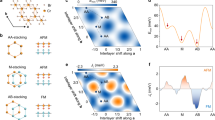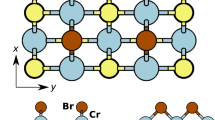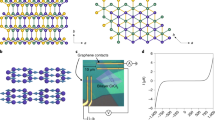Abstract
Changes in the spin configuration of atomically thin, magnetic van der Waals multilayers can cause drastic modifications in their opto-electronic properties. Conversely, the opto-electronic response of these systems provides information about the magnetic state, which is very difficult to obtain otherwise. Here, we show that in CrCl3 multilayers, the dependence of the tunnelling conductance on applied magnetic field, temperature and number of layers tracks the evolution of the magnetic state, enabling the magnetic phase diagram to be determined experimentally. Besides a high-field spin-flip transition occurring for all thicknesses, the in-plane magnetoconductance exhibits an even–odd effect due to a low-field spin-flop transition. Through a quantitative analysis of the phenomena, we determine the interlayer exchange coupling as well as the layer magnetization and show that in CrCl3 shape anisotropy dominates. Our results reveal the rich behaviour of atomically thin layered antiferromagnets with weak magnetic anisotropy.
This is a preview of subscription content, access via your institution
Access options
Access Nature and 54 other Nature Portfolio journals
Get Nature+, our best-value online-access subscription
$29.99 / 30 days
cancel any time
Subscribe to this journal
Receive 12 print issues and online access
$259.00 per year
only $21.58 per issue
Buy this article
- Purchase on Springer Link
- Instant access to full article PDF
Prices may be subject to local taxes which are calculated during checkout





Similar content being viewed by others
Data availability
All relevant data are available from the corresponding authors upon reasonable and well-motivated request.
References
Lee, J. U. et al. Ising-type magnetic ordering in atomically thin FePS3. Nano Lett. 16, 7433–7438 (2016).
Wang, X. et al. Raman spectroscopy of atomically thin two-dimensional magnetic iron phosphorus trisulfide (FePS3) crystals. 2D Mater. 3, 031009 (2016).
Kuo, C.-T. et al. Exfoliation and Raman spectroscopic fingerprint of few-layer NiPS 3 van der Waals crystals. Sci. Rep. 6, 20904 (2016).
Lin, M.-W. et al. Ultrathin nanosheets of CrSiTe3: a semiconducting two-dimensional ferromagnetic material. J. Mater. Chem. C. 4, 315–322 (2016).
Du, K.-z et al. Weak van der Waals stacking, wide-range band gap, and Raman study on ultrathin layers of metal phosphorus trichalcogenides. ACS Nano 10, 1738–1743 (2016).
Huang, B. et al. Layer-dependent ferromagnetism in a van der Waals crystal down to the monolayer limit. Nature 546, 270–273 (2017).
Gong, C. et al. Discovery of intrinsic ferromagnetism in two-dimensional van der Waals crystals. Nature 546, 265–269 (2017).
Ghazaryan, D. et al. Magnon-assisted tunnelling in van der waals heterostructures based on CrBr3. Nat. Electron. 1, 344–349 (2018).
Deng, Y. et al. Gate-tunable room-temperature ferromagnetism in two-dimensional Fe3GeTe2. Nature 563, 94–99 (2018).
Fei, Z. et al. Two-dimensional itinerant ferromagnetism in atomically thin Fe3GeTe2. Nat. Mater. 17, 778–782 (2018).
Wang, Z. et al. Tunneling spin valves based on Fe3GeTe2/hBN/Fe3GeTe2 van der Waals heterostructures. Nano Lett. 18, 4303–4308 (2018).
Wang, Z. et al. Electric-field control of magnetism in a few-layered van der waals ferromagnetic semiconductor. Nat. Nanotechnol. 13, 554–559 (2018).
Bonilla, M. et al. Strong room-temperature ferromagnetism in VSe2 monolayers on van der Waals substrates. Nat. Nanotechnol. 13, 289–293 (2018).
O’Hara, D. J. et al. Room temperature intrinsic ferromagnetism in epitaxial manganese selenide films in the monolayer limit. Nano Lett. 18, 3125–3131 (2018).
Burch, K. S., Mandrus, D. & Park, J.-G. Magnetism in two-dimensional van der Waals materials. Nature 563, 47–52 (2018).
Gong, C. & Zhang, X. Two-dimensional magnetic crystals and emergent heterostructure devices. Science 363, pii: eaav4450 (2019).
Gibertini, M., Koperski, M., Morpurgo, A. F. & Novoselov, K. S. Magnetic 2D materials and heterostructures. Nat. Nanotechnol. 14, 408–419 (2019).
Klein, D. R. et al. Probing magnetism in 2D van der Waals crystalline insulators via electron tunneling. Science 360, 1218–1222 (2018).
Song, T. et al. Giant tunneling magnetoresistance in spin-filter van der Waals heterostructures. Science 360, 1214–1218 (2018).
Wang, Z. et al. Very large tunneling magnetoresistance in layered magnetic semiconductor CrI3. Nat. Commun. 9, 2516 (2018).
Kim, H. H. et al. One million percent tunnel magnetoresistance in a magnetic van der Waals heterostructure. Nano Lett. 18, 4885–4890 (2018).
Jiang, S., Shan, J. & Mak, K. F. Electric-field switching of two-dimensional van der Waals magnets. Nat. Mater. 17, 406–410 (2018).
Jiang, S., Li, L., Wang, Z., Mak, K. F. & Shan, J. Controlling magnetism in 2D CrI3 by electrostatic doping. Nat. Nanotechnol. 13, 549–553 (2018).
Huang, B. et al. Electrical control of 2D magnetism in bilayer CrI3. Nat. Nanotechnol. 13, 544–548 (2018).
Jiang, S., Li, L., Wang, Z., Shan, J. & Mak, K. F. Spin tunnel field-effect transistors based on two-dimensional van der Waals heterostructures. Nat. Electron. 2, 159–163 (2019).
Song, T. et al. Voltage control of a van der Waals spin-filter magnetic tunnel junction. Nano Lett. 19, 915–920 (2019).
Stryjewski, E. & Giordano, N. Metamagnetism. Adv. Phys. 26, 487–650 (1977).
Majlis, N. The Quantum Theory of Magnetism 2nd edn (World Scientific, 2007).
Néel, Louis Propriétés magnétiques de l’état métallique et énergie d’interaction entre atomes magnétiques. Ann. Phys. 11, 232–279 (1936).
Ubbink, J., Poulis, J., Gerritsen, H. & Gorter, C. Antiferromagnetic resonance in copper chloride. Physica 19, 928–934 (1953).
de Jongh, L. & Miedema, A. Experiments on simple magnetic model systems. Adv. Phys. 23, 1–260 (1974).
Dieny, B., Gavigan, J. P. & Rebouillat, J. P. Magnetisation processes, hysteresis and finite-size effects in model multilayer systems of cubic or uniaxial anisotropy with antiferromagnetic coupling between adjacent ferromagnetic layers. J. Phys. Condens. Matter 2, 159–185 (1990).
Nörtemann, F. C., Stamps, R. L., Carriço, A. S. & Camley, R. E. Finite-size effects on spin configurations in antiferromagnetically coupled multilayers. Phys. Rev. B. 46, 10847–10853 (1992).
Wang, R. W., Mills, D. L., Fullerton, E. E., Mattson, J. E. & Bader, S. D. Surface spin-flop transition in Fe/Cr(211) superlattices: experiment and theory. Phys. Rev. Lett. 72, 920–923 (1994).
Rößler, U. K. & Bogdanov, A. N. Magnetic phases and reorientation transitions in antiferromagnetically coupled multilayers. Phys. Rev. B. 69, 184420 (2004).
Cable, J., Wilkinson, M. & Wollan, E. Neutron diffraction investigation of antiferromagnetism in CrCl3. J. Phys. Chem. Solids 19, 29–34 (1961).
Narath, A. Low-temperature sublattice magnetization of antiferromagnetic CrCl3. Phys. Rev. 131, 1929–1942 (1963).
Narath, A. & Davis, H. L. Spin-wave analysis of the sublattice magnetization behavior of antiferromagnetic and ferromagnetic CrCl3. Phys. Rev. 137, A163–A178 (1965).
Kuhlow, B. Magnetic ordering in CrCl3 at the phase transition. Phys. Status Solidi 72, 161–168 (1982).
McGuire, M. A. et al. Magnetic behavior and spin-lattice coupling in cleavable van der Waals layered CrCl3 crystals. Phys. Rev. Mater. 1, 014001 (2017).
Fowler, R. H. & Nordheim, L. Electron emission in intense electric fields. Proc. R. Soc. Lond. A. 119, 173–181 (1928).
Groot, H. D. & Jongh, L. D. Phase diagrams of weakly anisotropic Heisenberg antiferromagnets, nonlinear excitations (solitons) and random-field effects. Physica B + C. 141, 1–36 (1986).
Moodera, J. S., Hao, X., Gibson, G. A. & Meservey, R. Electron-spin polarization in tunnel junctions in zero applied field with ferromagnetic EuS barriers. Phys. Rev. Lett. 61, 637–640 (1988).
Worledge, D. C. & Geballe, T. H. Magnetoresistive double spin filter tunnel junction. J. Appl. Phys. 88, 5277–5279 (2000).
Klein, D. R.et al. Enhancement of interlayer exchange in an ultrathin two-dimensional magnet. Nat. Phys., https://doi.org/10.1038/s41567-019-0651-0 (2019).
Cai, X. et al. Atomically thin CrCl3: an in-plane layered antiferromagnetic insulator. Nano Lett. 19, 3993–3998 (2019).
Morosin, B. & Narath, A. X‐ray diffraction and nuclear quadrupole resonance studies of chromium trichloride. J. Chem. Phys. 40, 1958–1967 (1964).
MacNeill, D. et al. Gigahertz frequency antiferromagnetic resonance and strong magnon-magnon coupling in the layered crystal crcl3. Phys. Rev. Lett. 123, 047204 (2019).
Mills, D. L. Surface spin-flop state in a simple antiferromagnet. Phys. Rev. Lett. 20, 18–21 (1968).
Blazey, K. W., Rohrer, H. & Webster, R. Magnetocaloric effects and the angular variation of the magnetic phase diagram of antiferromagnetic GdAlO3. Phys. Rev. B. 4, 2287–2302 (1971).
Kim, H. H. et al. Evolution of interlayer and intralayer magnetism in three atomically thin chromium trihalides. Proc. Natl Acad. Sci. USA 116, 11131–11136 (2019).
Kim, H. H. et al. Tailored tunnel magnetoresistance response in three ultrathin chromium trihalides. Nano Lett. 19, 5739–5745 (2019).
Acknowledgements
We sincerely acknowledge N. Ubrig and H. Henck for helpful discussions and A. Ferreira for technical support. A.F.M. gratefully acknowledges financial support from the Swiss National Science Foundation (Division II) and from the EU Graphene Flagship project. Z.W. acknowledges the National Natural Science Foundation of China (Grants no. 11904276). M.G. acknowledges support from the Swiss National Science Foundation through the Ambizione programme. K.W. and T.T. acknowledge support from the Elemental Strategy Initiative conducted by the Ministry of Education, Culture, Sports, Science and Technology (MEXT), Japan, A3 Foresight by the Japan Society for the Promotion of Science (JSPS) and the CREST (JPMJCR15F3), Japan Science and Technology Agency (JST).
Author information
Authors and Affiliations
Contributions
Z.W., M.G. and A.F.M. conceived the work. D.D. and E.G. grew CrCl3 crystals and performed bulk characterization. T.T. and K.W. provided high-quality boron nitride crystals. Z.W. fabricated all samples and performed all transport measurements. M.G. carried out all theoretical modelling. Z.W., M.G. and A.F.M. analysed and interpreted the magnetoconductance data. All authors contributed to writing the manuscript.
Corresponding authors
Ethics declarations
Competing interests
The authors declare no competing interests.
Additional information
Publisher’s note Springer Nature remains neutral with regard to jurisdictional claims in published maps and institutional affiliations.
Supplementary information
Supplementary Information
Supplementary Notes 1–5, Figs. 1–10 and refs. 1–8.
Rights and permissions
About this article
Cite this article
Wang, Z., Gibertini, M., Dumcenco, D. et al. Determining the phase diagram of atomically thin layered antiferromagnet CrCl3. Nat. Nanotechnol. 14, 1116–1122 (2019). https://doi.org/10.1038/s41565-019-0565-0
Received:
Accepted:
Published:
Issue Date:
DOI: https://doi.org/10.1038/s41565-019-0565-0
This article is cited by
-
Ferrielectricity controlled widely-tunable magnetoelectric coupling in van der Waals multiferroics
Nature Communications (2024)
-
Two-dimensional magnetic materials for spintronic applications
Nano Research (2024)
-
Multiple antiferromagnetic phases and magnetic anisotropy in exfoliated CrBr3 multilayers
Nature Communications (2023)
-
Direct correlation between spin states and magnetic torques in a room-temperature van der Waals antiferromagnet
NPG Asia Materials (2023)
-
Emergence of electric-field-tunable interfacial ferromagnetism in 2D antiferromagnet heterostructures
Nature Communications (2022)



